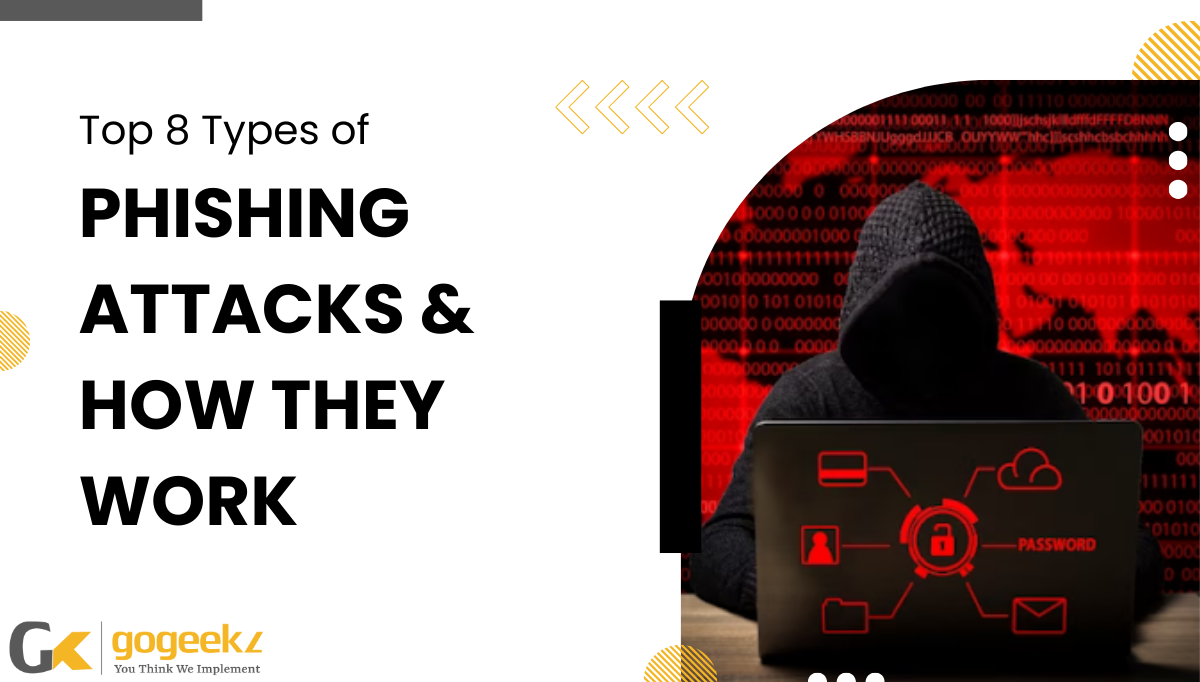10 Reasons Why IT Outsourcing is Essential for Modern Businesses
Phishing attacks have become a prevalent threat in the digital world. Understanding these attacks is crucial for protecting personal information and maintaining cybersecurity . In this blog, we’ll explore the top 8 types of phishing attacks and how they work, offering you genuine and valuable knowledge to make informed decisions and stay safe online.
1. Email Phishing
Email phishing is the most common type of phishing attack. It involves sending fraudulent emails that appear to come from legitimate sources, such as banks, online retailers, or even colleagues. These emails often contain a phishing link that directs recipients to a fake website where they are prompted to enter sensitive information like passwords or credit card numbers.
How It Works: The attacker creates an email that mimics a legitimate company, complete with logos and official-looking language. When recipients click the phishing link, they are taken to a spoofed website that looks almost identical to the real one. Once they enter their information, it is captured by the attacker.
2.Spear Phishing
Spear phishing is a more targeted form of phishing. Unlike general email phishing, spear phishing involves personalized emails sent to specific individuals. These emails are crafted based on information gathered about the target, making them more convincing.
How It Works: The attacker researches their target, often using social media and other public sources, to gather personal information. This allows them to craft a personalized email that seems trustworthy. The email might appear to come from a colleague or a trusted contact, increasing the likelihood that the target will fall for the scam.
3. Whaling
Whaling is a type of phishing attack that targets high-profile individuals within an organization, such as executives or senior management. These attacks are highly sophisticated and often involve considerable research to make the phishing attempt appear legitimate.
How It Works: Attackers focus on gathering detailed information about their high-value targets. They then craft emails that seem to come from trusted sources, such as other executives or business partners. These emails might request sensitive information, authorize large financial transactions, or even install malware on the executive’s computer.

4. Smishing
Smishing, a combination of “SMS” and “phishing,” involves phishing attacks carried out via text messages. These messages often contain a link to a fake website or a phone number to call, aiming to trick individuals into revealing personal information.
How It Works: Attackers send a text message that appears to come from a reputable source, such as a bank or an online service provider. The message usually contains urgent language, prompting the recipient to click on a link or call a number. Once they do, they are directed to a phishing website or a scammer who will try to extract sensitive information.
5. Vishing
Vishing, or voice phishing, involves fraudulent phone calls where attackers impersonate legitimate entities to steal personal information. This type of attack often targets the elderly or less tech-savvy individuals.
How It Works: The attacker calls the victim, pretending to be from a trusted organization, such as a bank or government agency. They use social engineering techniques to create a sense of urgency, convincing the victim to provide sensitive information, such as social security numbers or bank account details.
 6. Clone Phishing
6. Clone Phishing
Clone phishing involves creating a near-identical copy of a legitimate email that the victim has previously received. The cloned email contains malicious links or attachments and is sent from an address that appears to be from a trusted source.
How It Works: Attackers gain access to an email previously sent to the victim. They create a “clone” of this email, changing only the links or attachments to point to malicious content. Because the email looks familiar, the victim is more likely to trust it and click on the links or download the attachments.
7. Pharming
Pharming is a more technical type of phishing that involves redirecting a website’s traffic to a fake website without the user’s knowledge. This is often done by exploiting vulnerabilities in DNS (Domain Name System) servers .
How It Works: Attackers poison a DNS server, causing it to resolve a legitimate domain name to a fraudulent IP address. When users attempt to visit a legitimate website, they are unknowingly redirected to a fake one that looks identical. Any information entered on this fake site is captured by the attacker.
8. Business Email Compromise (BEC)
Business Email Compromise (BEC) is a sophisticated attack targeting companies that conduct wire transfers or have suppliers abroad. The attacker gains access to a business email account and uses it to trick employees into transferring money or sensitive data.
How It Works: Attackers use social engineering or spear phishing to gain access to a high-level business email account. They then send emails from this account to employees, instructing them to make wire transfers or provide confidential information. Because the email appears to come from a trusted source within the company, the requests are often fulfilled without suspicion.
How to Protect Yourself
To safeguard against these types of phishing attacks, consider the following tips:
- Be Skeptical: Always be cautious of unsolicited emails, texts, or phone calls, especially those requesting personal information.
- Verify Sources: Before clicking on a link or providing information, verify the source by contacting the company directly using a known and trusted contact method.
- Use Security Software: Keep your security software updated to protect against malware and other threats.
- Educate Yourself: Stay informed about the latest phishing tactics and learn how to recognize them.
By understanding these types of phishing attacks and how they work, you can better protect yourself and your organization from falling victim to these malicious schemes. Remember, staying vigilant and informed is your best defense against phishing.
FAQs
Industry Experiences
Innovative services for your business
We’re dedicated to making your businesses reliable, efficient, and safe.
We’re a one-stop solution for everything IT you need. Whatever you need, we got you covered:
Spear phishing is a targeted form of phishing where attackers personalize their messages to a specific individual or organization, often using information gathered from social media or other sources. Unlike regular phishing, which sends generic emails to a large number of people, spear phishing aims to deceive the recipient by appearing as a trustworthy entity. The goal is to make the email look credible and relevant to the recipient, thereby increasing the likelihood of success.
Spear phishing attacks can be highly sophisticated, involving detailed research and social engineering tactics. They often include the recipient’s name, position, or other personal details to create a sense of familiarity and trust.
Protect your business from sophisticated phishing attacks with GoGeekz’s comprehensive cybersecurity solutions.
Whaling attacks are a form of phishing that specifically targets high-profile individuals such as executives, CEOs, or other senior management members within an organization. These attacks are more sophisticated and personalized compared to standard phishing attacks. Whaling emails often appear to come from legitimate sources like business partners, legal authorities, or trusted colleagues and usually contain urgent or sensitive matters requiring immediate attention.
The objective of whaling attacks is to manipulate the target into disclosing confidential information, making financial transfers, or downloading malicious software. Due to their position, the impact of a successful whaling attack can be significantly damaging to the organization.
Safeguard your executives from whaling attacks with GoGeekz’s tailored cybersecurity strategies.
Vishing, or voice phishing, involves scammers using phone calls to trick individuals into revealing personal information, such as passwords, credit card numbers, or other sensitive data. Attackers often impersonate legitimate entities like banks, tech support, or government agencies to create a sense of urgency and trust.
Vishing can affect both individuals and businesses by leading to financial loss, identity theft, and unauthorized access to sensitive information. Businesses can suffer from compromised customer data, financial breaches, and damage to their reputation.
Prevent vishing attacks with GoGeekz’s advanced security measures and employee training programs.
Clone phishing involves duplicating a legitimate email previously sent to the victim and altering the attachment or link to a malicious one. The attacker sends this clone email to the recipient, making it appear as a follow-up or related communication, thereby exploiting the trust established by the original message.
Identifying clone phishing attacks can be challenging, but there are a few signs to watch for:
- Unexpected follow-up emails with attachments or links.
- Slight changes in the sender’s email address or domain.
- Urgent or unusual requests that differ from previous communications.
Enhance your email security with GoGeekz’s robust anti-phishing solutions.
Smishing, or SMS phishing, involves sending fraudulent text messages to trick recipients into divulging personal information or clicking on malicious links. These messages often appear to come from reputable organizations, such as banks or service providers, and typically contain urgent requests or enticing offers.
To prevent smishing attacks:
- Avoid clicking on links in unsolicited text messages.
- Verify the sender’s identity by contacting the organization directly through official channels.
- Use mobile security apps that can detect and block malicious messages.
- Educate employees and individuals about the risks and signs of smishing.
Protect your mobile devices from smishing attacks with GoGeekz’s comprehensive mobile security solutions.




 6. Clone Phishing
6. Clone Phishing 


